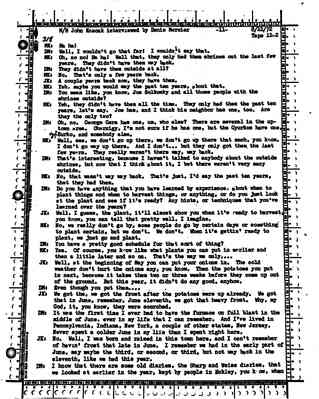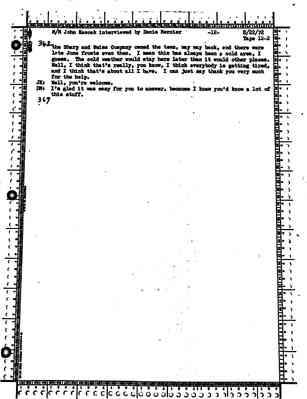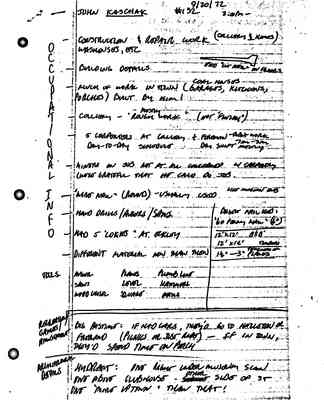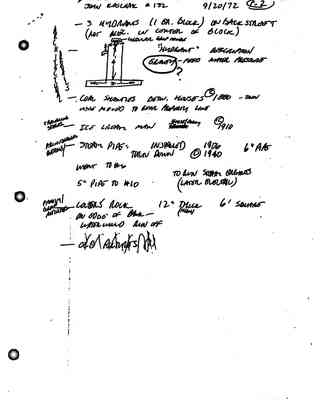Pages
12
8/22/72 Tape 12-2 --11-- 318 M/M John Kascak interviewed by Denis Mercier
MK: Ha ha! DM: Well, I wouldn't go that far! I wouldn't say that. MK: Oh, no no! Ha ha! Well that, they only had them shrines out the last few years. They didn't have them way back. DM: They didn't have them outside at all? MK: No. That's only a few years back. JK: A couple years back now, they have them. MK: Yeh, maybe you would say the past ten years, about that. DM: You mean like, you know, Joe Solkusky and all those people with the shrines outside? MK: Yeh, they didn't have them all the time. They only had them the past ten years, let's say. Joe has, and I think his neighbor has one, too. Are they the only two? DM: Oh, no. George Gera has one, um, who else? There are several in the uptown area. Charnigo, I'm not sure if he has one, but the Gyurkos have one, Gyurko, and somebody else. MK: Well, see, we don't go up there, we don't go up there that much, you know. I don't go way up there. And I don't...but they only got them the last few years. They really weren't there way, way back. DM: That's interesting, because I haven't talked to anybody about the outside shrines, but now that I think about it, I bet there weren't very many outside. MK: No, that wasn't way way back. That's just, I'd say the past ten years, that they had them. DM: Do you have anything that you learned by experience, about when to plant things and when to harvest things, or anything, or do you just look at the plant and see if it's ready? Any hints, or techniques that you've learned over the years? JK: Well, I guess, the plant, it'll almost show you when it's ready to harvest, you know, you can tell that pretty well, I imagine. MK: No, we really don't go by, some people do go by certain days or something to plant certain, but we don't. We don't. When it's gettin' ready to plant, we just go and plant. DM: You have a pretty good schedule for that sort of thing? MK: Yes. Of course, you know like what plants you can put in earlier and then a little later and so on. That's the way we only... JK: Well, at the beginning of May you can put your onions in. The cold weather don't hurt the onions any, you know. Then the potatoes you put in next, because it takes them two or three weeks before they come up out of the ground. But this year, it didn't do any good, anyhow. DM: Even though you put them... JK: We got the, we got the frost after the potatoes were up already. We got that in June, remember, June eleventh we got that heavy frost. Why, my God, it, you know, they were scorched. DM: It was the first time I ever had to have the furnace on full blast in the middle of June, ever in my life that I can remember. And I've lived in Pennsylvania, Indiana, New York, a couple of other states, New Jersey. Never spent a colder June in my life than I spent right here. JK: No. Well, I was born and raised in this town here, and I can't remember of havin' frost that late in June. I remember we had in the early part of June, say maybe the third, or second, or third, but not way back in the eleventh, like we had this year. DM: I know that there were some old diaries, the Sharpe and Weiss diaries, that we looked at earlier in the year, kept by people in Eckley, you know, when
13
8/22/72 Tape 12-2 --12-- 362
the Sharpe and Weiss Company owned the town, way way back, and there were late June frosts even then. I mean this has always been a cold area, I guess. The cold weather would stay here later than it would other places. Well, I think that's really, you know, I think everybody is getting tired, and I think that's about all I have. I can just say thank you very much for the help. JK: Well, you're welcome. DM: I'm glad it was easy for you to answer, because I knew you'd know a lot of this stuff. 369
14
Denis Mercier 7/20/72 John Kascak
He did construction and repair work for the colliery and homes, mostly done on washhouses, etc. A "cut nail" was used on the floors. [Following the previous sentence is a drawing of a nail. It is horizontal on the page, with the sharp pointed end on the left and the flat broader top on the right side.] Many of the buildings in town such as coal houses, garages, kitchens, and porches were built by him. The colliery is mostly "rough work," not "finish." The five carpenters at the colliery and the foreman didn't work a day-to-day schedule. The day shift was 7:00 AM to 3:00 PM. Miners on the job were not at all concerned with carpentry. They were grateful for the job done. A "wire man," round, was usually used like modern ones. (Biggest man used: "60 penny man," "6"; 12' x 12', 8' x 8', 12' x 14' timbers; 1 1/[illegible] -3" thickness of planks). Tools used were hand drills, anglers, saws, wood chisel, planes, level, square, plumb line, hammers, and mans[?]. Different material is used now than then. There were five "lokies" at Eckley. A big pastime was to go to Hazleton or Freeland for a picnic or just ride, if they had cars. If not, they spent time on the porch. There was a hydrant right under the museum sign, one above the clubhouse on the other side of the street, and one "more uptown" than that. On Back Street there were three, one each block, not necessarily in the center of the block. [Following the previous sentence is a drawing. It is drawn perpendicular on the page and appears to be a drawing of an old-fashioned fire hydrant. The body of the hydrant is a tall narrow rectangle, described as 4 feet tall. There is a base just below it, a narrow rectangle that is perpendicular to the top one, described as 3 feet in width. There is a downward curving spout coming out of the left side of the hydrant, described as 6 inches from the top. Above the drawing are the words "Circular grip handle" with a line pointing to a handle on the top of the hydrant, which is protrudes just above and is parallel to the top of the hydrant, with curved ends connecting it to the edges of the top of the hydrant. The top of the hydrant is described as 10 inches. Below the picture is "Gravity-feed water pressure".] Coal shanties below houses (c. 1880) were moved to the rear of the property line. The ice cream man had a horse and buggy. (c. 1910) A steam pipe was installed in 1906 (6" pipe). It was torn down around 1940. This went to #6 to run steam engines and later electric. A five inch pipe led to #10. Lover's rock was twelve inches thick or high and six feet square. It was on the edge of a bank and water would run off.
15
9/20/72 John Kaschak #132 2:00PMConstruction & Repair Work(??Homes) Washouses,etc -Building details -Much of work in town(coal houses garages, kitchens, porches) Built by him colliery- mostly "Rough Work"(Not "Formal") 5 carpenters at collery+Foreman-didn't work Day-To-Day Schedule Day Shift 7am-3pm mostly
miners on job not at all concerned w/ carpentry (none grateful that he cando job. "Wing naw" (Round0-Usually used [???] -Hand drivers/augers/saws Budget nail used Had 5 " ?okies" at ??Kloy '60 Penny Naw (6") differente material now ? than 12'x12' B*B' 12'x 14' Timbers Tools anvil planes plumb lane 11/2"- 3" Thicknessof planks saws level hammers wood? square nails
Relationship/Games/Amusement Big Pastime: If had cars, they'd go to hazelton or freeland {picnics on ? ?)- If in town, Ploy'd spend timon porch Architectural details Hydrant: one
16
Joan Kaschak # 132 9/20/72 1:2( circled)
- 3 hydrants ( 1 ea. block) on back street ( not (?) in corner of block) Architectural (?) ( written vertical on left side of page. ( Drawing of hydrant. Base is 3 ', height is 4') Top has a line to words " (?) Grip handle "Hydrant" description Gravity( circled)with question mark - feed water pressure - Coal shanties both house (?) 1880 - then were moved to rear property line Traveling stores - Ice cream man horse/(?) C(circled) 1910 Architectural details - Steam pipe: installed 1906 6' pipe Torn down C (circled) 1940 went to #6 5" pipe to #10 to run (?) engines (later electric) Family Group Activities - Lowevers rock 12" thick(high) 6' square on edge of BankWater would run off -(Old Runnes (?) ( crossed out))




